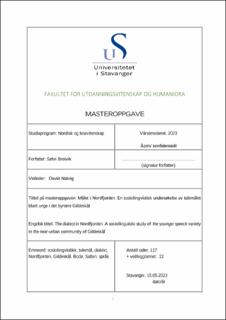| dc.contributor.advisor | Natvig, David | |
| dc.contributor.author | Breivik, Sølvi | |
| dc.date.accessioned | 2023-07-11T15:51:18Z | |
| dc.date.available | 2023-07-11T15:51:18Z | |
| dc.date.issued | 2023 | |
| dc.identifier | no.uis:inspera:146750637:95487360 | |
| dc.identifier.uri | https://hdl.handle.net/11250/3077640 | |
| dc.description.abstract | Denne masteroppgaven er en sosiolingvistisk studie av det yngre talemålet i bygda Nordfjorden i Gildeskål i Nordland fylke. Bygda har gjennom bedra infrastruktur gått fra å være geografisk forholdsvis isolert til å bli ei bynær bygd bare noen få mil fra Bodø. Samfunnsutviklinga har endra stedet fra et tradisjonelt fiskerbondesamfunn til ei bygd med moderne næringsveier som havbruk og turisme. Formålet med oppgaven er å studere tilstand og endringstendenser i talemålet blant unge mennesker i bygda, sett i lys av samfunnsendringene og den generelle tendensen til dialektnivellering i norske talemål. Det primære datamaterialet i studien kommer fra sosiolingvistiske dybdeintervju med fire av ungdommene i bygda, samt en bildetest. Målet med intervjua var både å samle inn språklige data og dessuten også kvalitative data for å forstå hvilke sosiale faktorer som virker inn på talemålet. Som diakront sammenligningsgrunnlag har jeg i tillegg innhenta flere historiske lydopptak av eldre mennesker i kommunen.
Resultata av studien viser at ei tilnærming til bydialekten holder på å skje, men at omfanget av tilnærminga varierer. De mest sentrale teoriene for å forstå talemålssituasjonen og de ulike språklige strategiene blant informantene i studien er den sosiale nettverksteorien og akkommodasjonsteorien. Et funn er at ungdommene utvikler ulike språklige strategier i den talemålssituasjonen de vokser opp i, hvor det tradisjonelle talemålet brytes mot både bymålet og standardmålet på grunn av hyppige kontaktsituasjoner. Jeg identifiserer i analysen av datamaterialet tre språklige strategier blant informantene, og disse kaller jeg for bymålsstrategien, tradisjonsstrategien og kompromisstrategien. Derimot ser identifikasjon med hjemstedet, orientering inn eller ut av bygda og personlighet ut til å spille en mindre rolle for valg av språklig strategi hos de fire informantene i denne studien. | |
| dc.description.abstract | This master thesis is a sociolinguistic study of the younger speech variety in the community of Nordfjorden, located in the rural district of Gildeskål in Nordland County. Improved infrastructure has converted this settlement from a geographically isolated to a near-urban village located a few miles from the city of Bodø. In addition, societal developments have transformed the district from a traditional fishing and farming community to one that relies on other sources of income, such as aquaculture and tourism. The aim of the thesis is to study variation and change in the spoken variety among young people in the village, in the light of both these societal changes and the general tendency toward dialect levelling in Norwegian spoken language. The primary data in the study were collected during in-depth sociolinguistic interviews and a picture-naming task with four young informants. The objective of the interviews was to collect linguistic as well as qualitative data in order to analyze the factors that influence the informants’ speech. For diachronic comparison, I also collected historical audio recordings of older individuals in the municipality.
The results of the study show advergence toward the urban variety, but that the extent of the advergence varies. Social network theory and accommodation theory are the key approaches in the understanding of the dialectal situation in this community. I argue that the informants develop different linguistic strategies in the spoken language situation in which they are growing up, where, due to frequent contact situations, the traditional dialect is influenced both by the urban and the standard varieties. I identify among three primary strategies, which I refer to as the urban strategy, the tradition strategy, and the compromise strategy. However, identification with the local community, orientation toward or out of their home district and personality seem to play a less important role in the choice of linguistic strategies among the informants in this study. | |
| dc.language | nob | |
| dc.publisher | uis | |
| dc.title | Målet i Nordfjorden. En sosiolingvistisk undersøkelse av talemålet blant unge i det bynære Gildeskål | |
| dc.type | Master thesis | |
